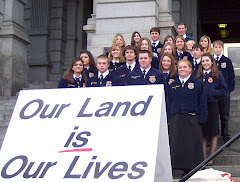Here are the facts:
Shortgrass prairie makes up approximately one third of Colorado, and only about 40 percent of this prairie remains. Much of what's left is degraded because of development, highways, and water projects. And in this instance the biggest threat in this region is from the Army.
Grazing by large ruminants is a keystone process of the grassland ecosystem. A keystone process is one that has significant impact on the entire ecosystem. Grazing begins with the plant-grazer interaction but the effects of grazing are critical to species at all levels of the system.
Perhaps there were once concerns about over grazing however the many benefits of the sustainable generational ranching practices have proven invaluable to eliminating that concern. In addition there has been continual long term (generations) efforts to properly care for and improve the overall health of the grasslands through careful management of our sacred natural resources.
Grazing is absolutely necessary for healthy grasslands. In a world without buffalo and with fences and roads the management of grazing determines it’s positive and negative affects.
1. A grassland ecosystem responds the same to cattle grazing as it does to bison grazing
2. Sustainable generational ranching families depend on the ecosystem they manage for their livelihood. They maximize economic production by maximizing ecosystem health.
3. Those sustainable generational ranchers in Southeastern Colorado have a wealth of cultural/historical knowledge that guides them in grazing management. These decades and centuries old knowledge based ranchers interact with the land daily and gather monitoring information on their livestock and grasslands that guide their management decisions.
4. Results from the preliminary independent study being performed by the Colorado Natural Heritage Program (CNHP) show that southeast Colorado rangelands under private management are in extremely good health and harbor a multitude of rare plant and animal species
Plants: plants developed defenses against grazing, for instance thorns on cactus or the production of poisons. However, other plants developed symbiotic relationships to grazing animals. For example many species rely on grazing to spread seeds in manure, to insert seeds into the soil through trampling, or to stimulate root activity by grazing the plant.
Soil: Plants extract nutrients from the soil and through photosynthesis produce cellulose and lignin. Cellulose and lignin are very stable organic molecules that decompose very slowly. Grazing animals play a critical role in the nutrient cycle by breaking down plant matter and returning nutrients to micro-organisms in the soil.
Habitat Structure: Grasslands, like forests, have successional sequences of plants and associated organisms in the soil. Grazing is a necessary and minimal disturbance that locally rewinds the successional sequence. Local disturbance and “out of sequence successional regimes” lead to greater plant and animal diversity. For example these local structural variations are critical to many bird species that might nest in open areas with high visibility but require thicker taller grasses or shrubs for feeding habitat.
.
Subscribe to:
Post Comments (Atom)
Blog Archive
-
▼
2010
(60)
-
▼
February
(13)
- Are you on FB? Check out our Fan numbers.....Rising!
- From the La Junta Tribune: "Romanoff well received...
- Grazing necessary for sustainable ecosystems...
- 'Heartening'
- Are you part of your Party's Caucus process? It's...
- Opposition Groups Honored by LaJunta Chamber
- A reprint from Doug's Pilgrimage Blog.......
- Romanoff opposes Pinon Canyon - Pueblo Chieftain
- Romanoff opposes Pinon Canyon expansion; Calls for...
- Poll update from Rasmussen on Colo Senate race: Be...
- We need more common sense......
- Western Slope water and Southeastern/Eastern Plain...
- Colorado Springs HAS NOT lost military jobs like s...
-
▼
February
(13)


No comments:
Post a Comment